Walters Electrical Morse Key: British Post Office Key
The Walters Electrical Morse key is a classic example of the type of Morse key used by the British Post Office, heavier than the steel lever keys used in the USA, it was ideal for the UK.
Morse Telegraph History Includes:
Morse telegraph history
Morse keys development
Vibroplex & mechanical bug keys
Telegraph sounder
Morse inker
Samuel Morse
Fascinating facts
Morse code SOS message
Morse keys:
Clipsal key
Camelback
Walters Electrical Patt 1056A Post Office key
Steel lever Morse telegraph key
RAF Bathtub Morse key
Samson ETM-5C electronic keyer
The Walters Electrical Morse telegraph key was widely used in British telegraph offices. Keys of this style were in use from the 1880s through to the 1950s.
The key is often stamped Pattern 1056A or more exactly "Patt. 1056A" on the side of the wooden base.
Video: Walters British Post Office Morse key
The Walters Electrical Morse telegraph key is relatively common, although still sought after by collectors as it is a very good example of the type of Morse telegraph key used in the UK.
It can be seen that this telegraph key is much heavier than the steel elver keys that were normally used in the USA. European keys often tended to be heavier than their US counterparts as they were normally fixed in an office and not owned by individual operators who would need to take their keys with them.
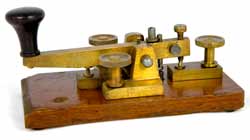
It is believed that this key was manufactured, possibly around 1900, although it is difficult to palce an exact date on it.
Walter's Electrical telegraph key details
The Walters Electrical Morse key is built upon a wooden base. Normally this would be fixed to a work top as most of these telegraph keys have countersunk screw holes in the base, obviously for fixing them down.
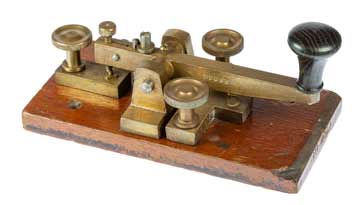
There are several elements to the key itself and these are fixed to the base:
Main contact: The first brass element on the key - the one closest to the operator - has the contact for the key down position. It also has the contact and the screw terminal to connect to the wire.
Centre assembly: The centre assembly is the most complicated, contains the bearing and its mount along with the lever. It also contains the centre or common contact for the key as well - also with a screw terminal.
Second contact and "open" stop: The third brass element on the key is the open position stop, and also a second contact. This is used for what is called dual current operation. As with the other brass sub-assemblies on the wooden base, there is a screw terminal.
Spring: Between the lever assembly and the second contact assembly, the tension spring is located. This provides the tension to bring the key back to the open position when the key is in the rest position with no pressure applied to the knob.
The under side of the telegraph key shows the fixing screws for the different sub assemblies. The brass sub-assemblies have large slot screws that are fitted in countersunk holes in the wooden base - this stops them protruding and causing problems. The spring is fixed to a wire that is fitted into a slot cut in the base.
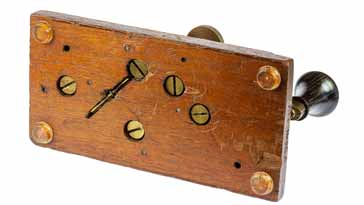
The dimensions of the base are 3.07 inches (78mm) wide, by 6 inches ( mm) long and the base is 0.5 inches (13mm) thick. The whole assembly - bench surface to top of the handle is 2.8 inches (72mm), although this will depend on whether any pads are included under the wooden base. The measurement taken excludes the plastic feet attached to the model used for the photos and measurements. These had obviously been added by a previous owner / user of the key.
Pattern 1056A marking
The Walters Electrical telegraph key was also known as a Pattern 1056A key - the marking can be seen on the wooden base. Many keys have this indentation filled with white paint, but it can be seen on this example, that much of the paint has worn away with years of use.
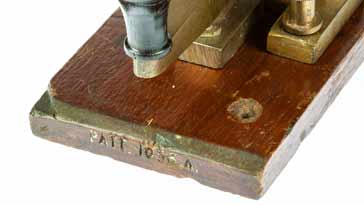
Another marking can be seen on the key, this time it is seen (upside down) on the lever. It must be assumed that this is a casting number as it says WE8208 and a little further along there is a copyright © mark.
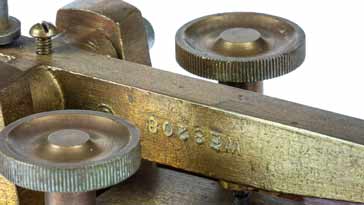
It would appear that the WE in the WE8208 identification stands for Walters Electrical.
British Post Office
The Walters Electrical telegraph key was widely used as the Post Office, as it was known int he UK had a monopoly withint he United Kingdom for owning and operating telegraph offices.
The Telegraph Act of 1869 gave the the Post Office a monopoly in telegraphic communication in the UK and as a result the responsibility for the 'electric telegraphs' was officially transferred in 1970 to the Post office or General Post Office GPO as it was more correctly known.
As a result of this existing private telegraph companies were bought out at its peak the telegraph service had 1,058 telegraph offices in towns and cities as well as 1,874 offices at railway stations.
This meant that there was a great need for Morse telegraph keys, and a number of similar types were used, one of which was the one from Walters Electrical.
In use
In use the Walters key gave a good account of itself. It had a good "feel" and it was easy to use. The weight of the lever and the overall assembly meant that it provided a good positive keying action without being too heavy.
The weight of the key and the plastic feet fitted meant that it did not wander across the work-surface on which it was being used. However, if needed it could be fixed to a surface using the existing screw holes and this would mean that it would not be necessary to damage the key for this.
The Walters Electrical Pat 1056A Morse telegraph key is a fine example of the type of key used by the British Post Office from the 1880s until the 1950s / 1960s when Morse telecommunications ceased. Although a variety of manufacturers were used for their keys, the Walters Electrical type is probably one of the most iconic.
 Written by Ian Poole .
Written by Ian Poole .
Experienced electronics engineer and author.
More History:
Radio history timeline
History of the radio
Ham radio history
Coherer
Crystal radio
Magnetic detector
Spark transmitter
Morse telegraph
Valve / tube history
PN junction diode invention
Transistor
Integrated circuit
Quartz crystals
Classic radios
Mobile telecoms history
Vintage mobile phones
Return to History menu . . .




